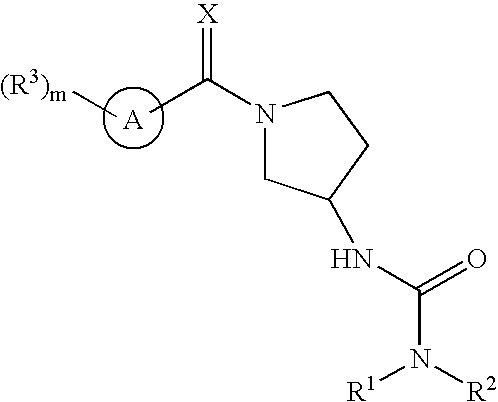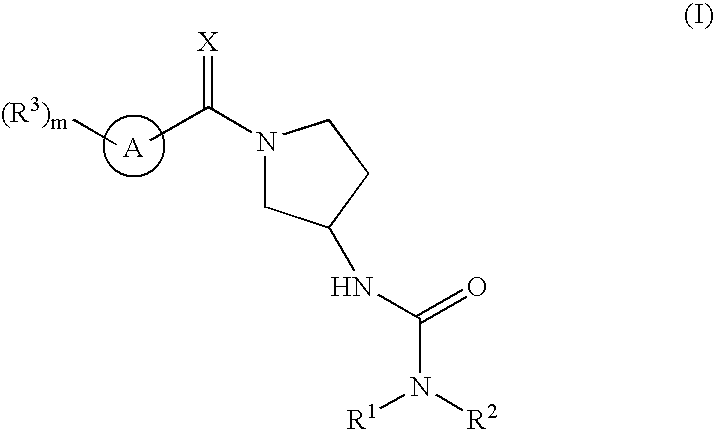Ureas having antiangiogenic activity
a technology of urea and antiangiogenic activity, which is applied in the field of compounds, can solve the problems of rapid proliferation and turnover of the same cells, and achieve the effect of reducing the risk of toxicity
- Summary
- Abstract
- Description
- Claims
- Application Information
AI Technical Summary
Benefits of technology
Problems solved by technology
Method used
Image
Examples
example 1
N-benzyl-N′-{(3R)-1-[(6-methylpyridin-3-yl)carbonyl]pyrrolidin-3-yl}urea
[0121] To a mixture of (3R)-1-[(6-methylpyridin-3-yl)carbonyl]pyrrolidin-3-amine bis-trifluoroacetate (0.433 g, 1.0 mmol) and triethylamine (0.418 mL, 3.0 mmol) in methylene chloride (5 ml) was added carbonyldiimidazole (0.178 g, 1.1 mmol). The reaction mixture was stirred for five hours at room temperature, at this point benzylamine (0.328 mL, 3.0 mmol) was added. The reaction mixture was stirred for additional four hours, then the solution was washed three times with water. The organic phase was dried over anhydrous sodium sulfate, filtered and the filtrate was concentrated in vacuo. The crude product was then purified by HPLC using C-18 column and a solvent mixture varying in a gradient of 10% to 90% acetonitrile / water containing 0.1% TFA. The pure fractions were lyophilized to yield 0.385 g of the title compound as the TFA salt, which subsequently was dissolved in methylene chloride (5 mL) and shaken with a...
example 2
N-{(3R)-1-[(6-methyl-3-pyridinyl)carbonyl]-3-pyrrolidinyl}-1-pyrrolidinecarboxamide
[0123] The procedure described in example 1 was used but substituting pyrrolidine instead of benzylamine. The reaction mixture was worked-up and the crude product was then purified by HPLC using C-18 column and a solvent mixture varying in a gradient of 10% to 90% acetonitrile / water containing 0.1% TFA. The pure fractions were lyophilized to yield 0.385 g of the title compound as the TFA salt. This was dissolved in methylene chloride and shaken with a MP-carbonate resin to yield the product as free base. The resin was filtered, the filtrate was concentrated in vacuo and the residue was dissolved in diethyl ether. To the solution was added drop-wise a solution of 2M HCl in ether. The white precipitate was filtered and re-crystallized from methanol / ethylacetate / hexane system to yield the title compound as hydrochloride salt; MS showed (M+H)+ @ 303; NMR (d6DMSO, δ): 1.73-1.83 (m, 4H), 1.84-2.13 (m, 2H),...
example 3
N-{(3R)-1-[(6-methyl-3-pyridinyl)carbonyl]-3-pyrrolidinyl}-N′-[3-(4-morpholinyl)propyl]urea
[0124] The procedure described in example 1 was used but substituting 4-(3-aminopropyl)morpholine for benzylamine. After workup the crude product was purified by HPLC using C-18 column and a solvent mixture varying in a gradient of 10% to 90% acetonitrile / water containing 0.1% TFA. The pure fractions were lyophilized to yield the title compound as the TFA salt. This was dissolved in methylene chloride and shaken with a MP-carbonate resin to yield the desired product as the free base:
[0125] MS showed (M+H)+ @ 376; NMR (d6DMSO, δ): 1.45-1.63 (m, 4H), 1.70-1.85 (m, 2H), 1.97-2.15 (m, 2H), 2.15-2.44 (m, 4H), 2.50 (s, 3H), 2.94-3.2 (m, 2H), 3.45-3.69 (m, 6H), 4.02 (m, 0.5H), 4.15 (m, 0.5H), 7.33 (d, 1H), 7.79 (t, 1H), 8.57 (d, 1H).
PUM
 Login to View More
Login to View More Abstract
Description
Claims
Application Information
 Login to View More
Login to View More - R&D
- Intellectual Property
- Life Sciences
- Materials
- Tech Scout
- Unparalleled Data Quality
- Higher Quality Content
- 60% Fewer Hallucinations
Browse by: Latest US Patents, China's latest patents, Technical Efficacy Thesaurus, Application Domain, Technology Topic, Popular Technical Reports.
© 2025 PatSnap. All rights reserved.Legal|Privacy policy|Modern Slavery Act Transparency Statement|Sitemap|About US| Contact US: help@patsnap.com



